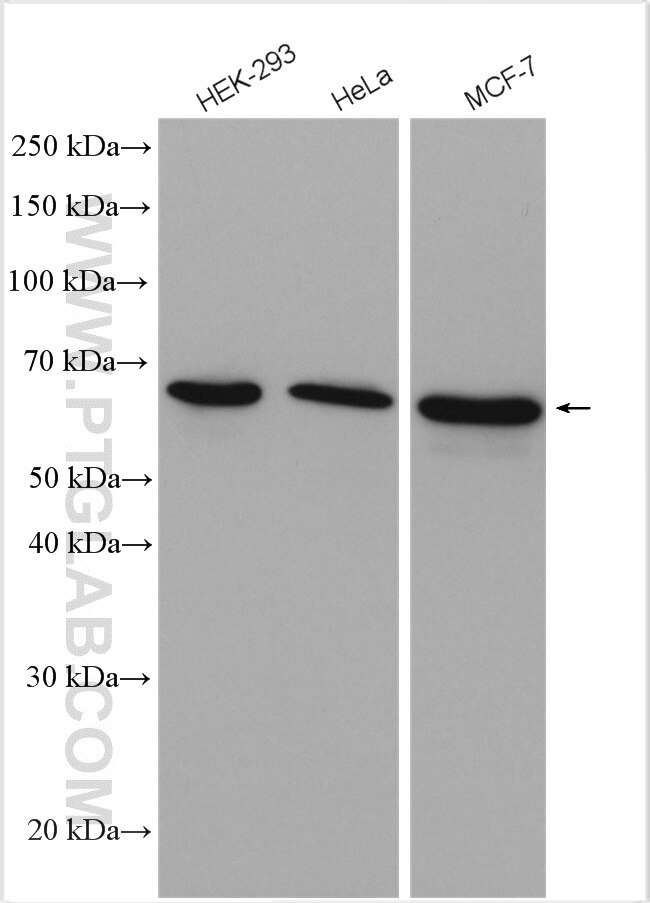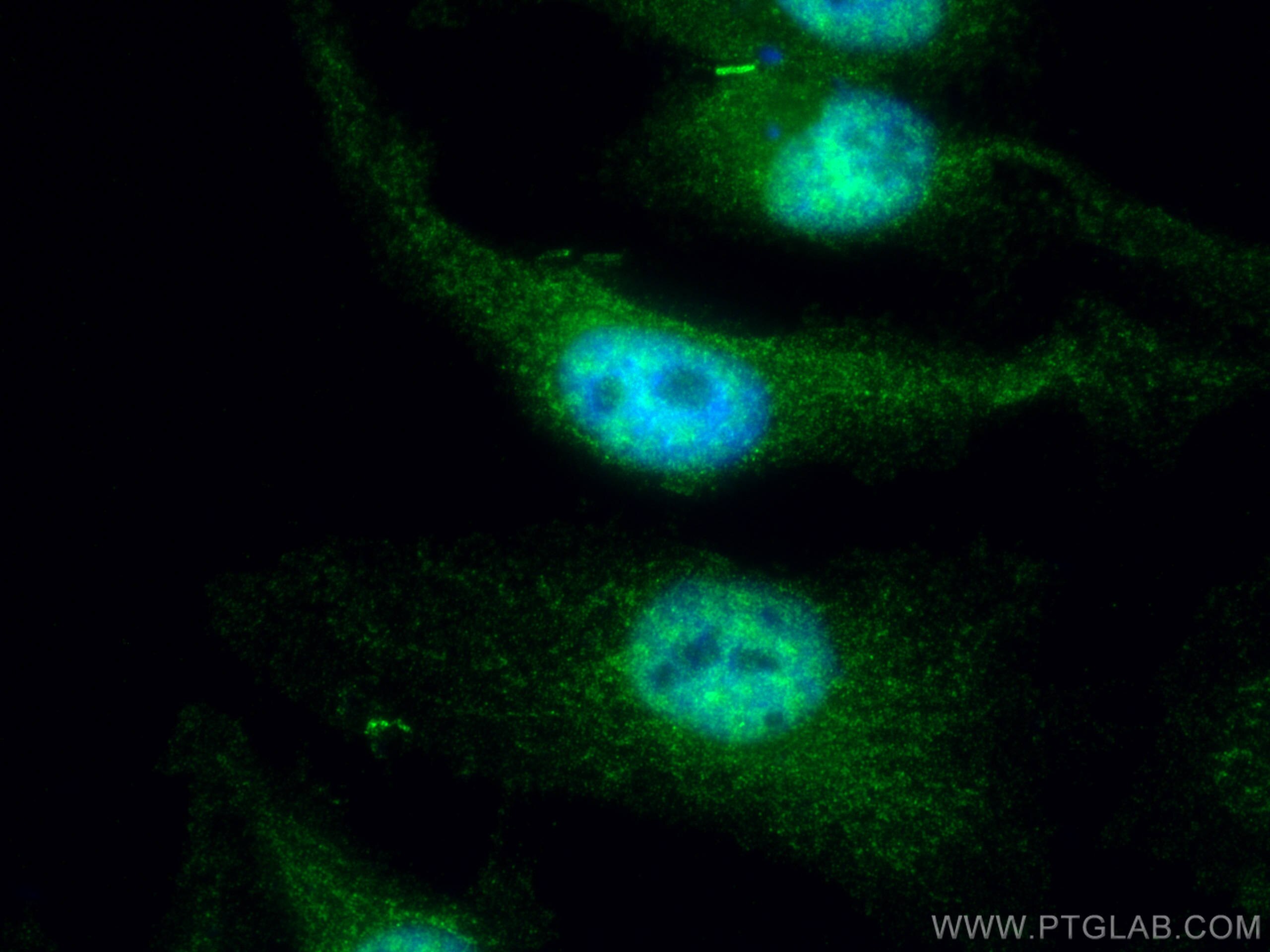- Featured Product
- KD/KO Validated
CBLL1 Polyklonaler Antikörper
CBLL1 Polyklonal Antikörper für IF, IHC, WB, ELISA
Wirt / Isotyp
Kaninchen / IgG
Getestete Reaktivität
human, Maus
Anwendung
WB, IHC, IF, ELISA
Konjugation
Unkonjugiert
Kat-Nr. : 21179-1-AP
Synonyme
Galerie der Validierungsdaten
Geprüfte Anwendungen
| Erfolgreiche Detektion in WB | HEK-293-Zellen, HeLa-Zellen, MCF-7-Zellen |
| Erfolgreiche Detektion in IHC | humanes Kolonkarzinomgewebe, humanes Lungenkarzinomgewebe Hinweis: Antigendemaskierung mit TE-Puffer pH 9,0 empfohlen. (*) Wahlweise kann die Antigendemaskierung auch mit Citratpuffer pH 6,0 erfolgen. |
| Erfolgreiche Detektion in IF | HeLa-Zellen |
Empfohlene Verdünnung
| Anwendung | Verdünnung |
|---|---|
| Western Blot (WB) | WB : 1:1000-1:6000 |
| Immunhistochemie (IHC) | IHC : 1:50-1:500 |
| Immunfluoreszenz (IF) | IF : 1:200-1:800 |
| It is recommended that this reagent should be titrated in each testing system to obtain optimal results. | |
| Sample-dependent, check data in validation data gallery | |
Veröffentlichte Anwendungen
| KD/KO | See 3 publications below |
| WB | See 6 publications below |
| IF | See 2 publications below |
Produktinformation
21179-1-AP bindet in WB, IHC, IF, ELISA CBLL1 und zeigt Reaktivität mit human, Maus
| Getestete Reaktivität | human, Maus |
| In Publikationen genannte Reaktivität | human, Maus |
| Wirt / Isotyp | Kaninchen / IgG |
| Klonalität | Polyklonal |
| Typ | Antikörper |
| Immunogen | CBLL1 fusion protein Ag15463 |
| Vollständiger Name | Cas-Br-M (murine) ecotropic retroviral transforming sequence-like 1 |
| Berechnetes Molekulargewicht | 491 aa, 55 kDa |
| Beobachtetes Molekulargewicht | 55-60 kDa |
| GenBank-Zugangsnummer | BC027460 |
| Gene symbol | CBLL1 |
| Gene ID (NCBI) | 79872 |
| Konjugation | Unkonjugiert |
| Form | Liquid |
| Reinigungsmethode | Antigen-Affinitätsreinigung |
| Lagerungspuffer | PBS mit 0.02% Natriumazid und 50% Glycerin pH 7.3. |
| Lagerungsbedingungen | Bei -20°C lagern. Nach dem Versand ein Jahr lang stabil Aliquotieren ist bei -20oC Lagerung nicht notwendig. 20ul Größen enthalten 0,1% BSA. |
Hintergrundinformationen
Cbl proto‐oncogene E3 ubiquitin protein ligase‐like 1, RNF188, Hakai (CBLL1) is an evolutionarily conserved E3 ubiquitin ligase containing a RING‐finger domain. CBLL1 contains a typical RING‐finger, short pTyr‐binding domain, and proline‐rich domain. CBLL1 expression is upregulated in human colon and gastric cancer tissues, and CBLL1 has been reported to induce anchorage‐dependent cell growth. CBLL1 immunostaining was observed in both the nuclei and cytoplasm of cancer cells. (PMID: 31124298, PMID: 31646569, PMID: 21191016)
Protokolle
| Produktspezifische Protokolle | |
|---|---|
| WB protocol for CBLL1 antibody 21179-1-AP | Protokoll herunterladen |
| IHC protocol for CBLL1 antibody 21179-1-AP | Protokoll herunterladen |
| IF protocol for CBLL1 antibody 21179-1-AP | Protokoll herunterladen |
| Standard-Protokolle | |
|---|---|
| Klicken Sie hier, um unsere Standardprotokolle anzuzeigen |
Publikationen
| Species | Application | Title |
|---|---|---|
J Ginseng Res Ginsenoside Rh2 reduces m6A RNA methylation in cancer via the KIF26B-SRF positive feedback loop | ||
Mol Biol Cell Minus end-directed motor KIFC3 suppresses E-cadherin degradation by recruiting USP47 to adherens junctions.
| ||
Med Oncol Celastrol inhibits the migration and invasion and enhances the anti-cancer effects of docetaxel in human triple-negative breast cancer cells
| ||
Front Genet Identification and experimental validation of key m6A modification regulators as potential biomarkers of osteoporosis |






